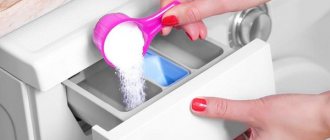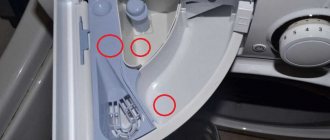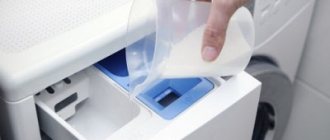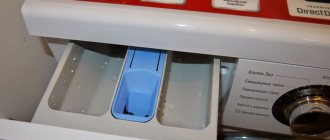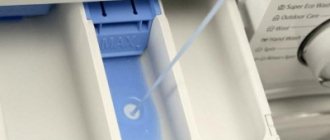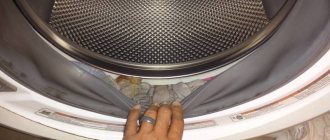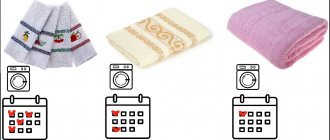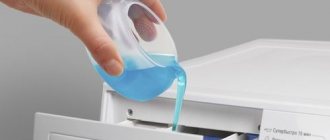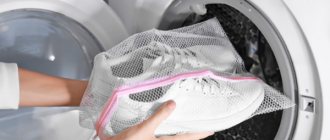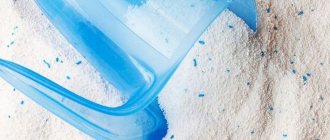- Standard marking of trays for loading detergents and their purpose
- Where to pour liquid and loose powder in the washing machine: general recommendations
- Options for loading washing powder into automatic machines from different manufacturers: photo instructions
- How to place powder in a semi-automatic washing machine and which one is better to use
- How much powder to pour into the washing machine: requirements from manufacturers and washing modes
- Loading powder into the drum at different modes: 30, 40, 60°C
Standard marking of trays for loading detergents and their purpose
There are “washing machines” that are not equipped with a compartment for filling detergents, but if such equipment is present, then it is important to know exactly which section is responsible for what. Often the tray is divided into three containers, masked with a certain symbol. Let's take a closer look.
| Symbol | Explanation and purpose |
| I (1) or A | This compartment is designed to be filled with washing powder or liquid gel detergent. During operation, the washing machine fills this container with water only if the selected washing function provides for pre-cleaning of items. You can also place bleaches and stain removers in this compartment. |
| II (2) or B | This marking indicates that the tray is intended for loading powder or any detergent for the main wash. |
| * ❄ star or snowflake | In terms of size, this compartment is usually the narrowest and smallest; its function is to wash out fabric softeners or fabric softeners. Begins to be used only during the last rinse stage. |
Good to know!
Do not place bleach or stain removers directly into the drum. Even the correctly selected washing mode will not save the item from damage.
How to download correctly?
Washing machines from different manufacturers have significant differences in the range of programs and washing modes. The amount of powder that will be consumed during a particular washing program is indicated in the operating instructions for the household appliance. In addition, each manufacturer of synthetic detergent for automatic cars indicates its approximate dosage on the packaging. But all this data is conditional.
The following factors may influence the dosage of washing powder.
Load powder, stain remover or bleach strictly into the appropriate tray before starting the washing process.
In order to pour the powder, it is best to use a special measuring cup.
It has a convenient spout that allows you to pour powder exactly into the compartment, and there are marks on its walls, making it easy to measure the required amount of powder. You can buy it at any hardware store. Also, some manufacturers of washing powders put it in the package with the product as a nice bonus. This usually applies to packages with a large weight.
There is an opinion that the powder can be poured directly into the drum after loading laundry there. This method has both positive and negative sides.
The advantages include:
The disadvantages of the method include:
If there is a need to add the product directly to the drum, you need to use special plastic containers for this.
Their use will protect the laundry from bleaching, and small holes in the lid of such a container will allow the powder to dissolve inside and the soap solution to be poured into the drum gradually.
Detergent in the form of gels and capsules can be loaded directly into the drum of the washing machine. Most often, they do not have aggressive components, and their application to clothing will not damage it.
In some models of washing machines, manufacturers have provided a dispenser for gel-based laundry care products.
It is a plate that must be installed in the main powder compartment, where special grooves are located. Then pour in the gel. There will be a small space between this partition and the bottom of the compartment, through which the gel will enter the drum only when the water supply starts.
Where to pour liquid and loose powder in the washing machine: general recommendations
You can find out which compartment you need to pour detergents into directly in the instructions for your household appliances. If for some reason it is missing, pay attention to the symbols from the previous section.
Washing things with liquid detergent is done in cases where dry powders are not reliable. It is important to know which compartment of the tray to pour it into:
- Liquid bleach or gel-based stain remover is placed in the compartment labeled I (1) or A. These chemicals are intended for pre-washing clothes.
- The liquid product in capsules is poured directly into the drum of the washing machine and dissolves there. If you put it in the filler compartment, then under weak water pressure the capsule does not dissolve and does not penetrate dirty laundry.
- Bulk detergent is placed in the compartment marked I for pre-wash or hole II for the main mode.
- Liquid rinse aids are always poured into the smallest size container. On many models it has an additional cover and is indicated in blue, in which it has a small hole.
Caring for the washing machine cuvette
In order for the powder receptacle to work properly for a long time, it is necessary to follow a number of recommendations.
After each wash, it is necessary to remove all remnants of laundry detergents (rinse aid, powder), as well as excess moisture, and then dry the cuvette, leaving it open. Periodically, air conditioner must be poured into the compartment. After soaking, the cuvette is removed from the niche and then thoroughly washed with a brush.
At the same time, the walls of the hole are also cleaned, where dust and accidentally spilled powder often accumulate.
[custom_ads_shortcode1]
Options for loading washing powder into automatic machines from different manufacturers: photo instructions
If you correctly study the design of trays in modern washing machines, understanding the method of loading detergents is not so difficult. However, to make it easier to find the right compartment, our editors offer visual instructions with photos for each individual brand of popular automatic washing machines.
Features of the structure of the trays in the Indesit washing machine: where to pour the powder into them
Most modern washing machines from the Indesit brand have three compartments for storing detergents. The widest tank, indicated by the arrow, is intended for dry powder or liquid detergent for the main wash cycle.
Where to put powder in an LG washing machine for the main washing function
In washing machines of the LG brand, the placement of trays is individual, for example, the compartment for placing rinse aids or conditioners is located right in the depths of the pre-wash tank. But you need to pour powder for regular washing of things into the compartment with icon II, as shown in the photo.
Where to put washing powder in a Samsung automatic machine?
Regardless of the model of Samsung washing machines, the internal structure of the detergent tanks is practically the same. Take a look at the photo where to correctly send the powder for the main washing cycle. If you are using liquid products or capsules, they must be placed directly into the drum.
Helpful information!
If you hold the tray open for a few minutes while the wash is running, you will see where the water is collected first, and accordingly, you will be able to determine where to send the powder.
In which compartment of the Bosch washing machine should I pour pre-wash powder?
In the previous section, you have already become familiar with the methods of marking trays for detergents. If you need to thoroughly wash laundry or remove stains from children's clothing, you need to start the pre-wash mode, respectively, pour washing powder into the compartment marked (I), see photo.
Determining the optimal amount of funds
Depending on the selected program, the following products must be added when washing products:
- For simple washing, just pour the powder into the cell marked with the letter B or the number 2 (II).
- For a full cycle with soaking and rinsing with the addition of softener, powder is loaded into compartments A and B, and conditioner is poured into the tray marked with 3 or a “flower”.
- If the laundry is not heavily soiled, you can do without pre-soaking. In this case, it is enough to add detergent to compartment B (II); If desired, rinse aid can also be added to the small compartment.
Conditioner (fragrance, rinse aid) can be poured into the tray at any stage of the process until the start of the final stage (rinsing and spinning).
What affects the amount of powder?
The amount of detergent required for washing depends primarily on the volume of items loaded into the machine.
In addition, factors such as:
- degree of soiling of the laundry;
- hardness of water;
- amount of water required for washing;
- selected program;
- washing technology.
The more stains on the products, the higher the consumption of detergent. If the stains are complex, it is better to use a stain remover or bleach.
An alternative to industrial water softeners can be a few tablespoons of baking soda, which is added to the powder compartment. You just need to keep in mind that this product should not be used when washing wool and silk items.
Washing in soft water requires less powder than in hard water. To determine what type of water is in your region, just look at the transparent window when you start washing. If bubbles are visible on it, it means that soft water is flowing from the taps.
The liquid can be softened artificially by adding a special product containing phosphates to the washing powder. A large volume of washing water implies an increased content of detergents.
Different modes involve the use of a certain amount of washing powder. In some cases, the difference can be striking: for example, when washing 3 kg of laundry in the “Cotton” mode at +60 °C, 6 tablespoons of detergent will be required, whereas when choosing the “Synthetics” program at +40 °C, only three are required.
It is also necessary to use liquid gel in a certain amount. Increasing the laying rate only leads to wasteful use of the product, while the quality of washing remains unchanged
Innovative solutions used in modern models of washing machines from the best manufacturers can reduce the consumption of electricity, water, and detergents.
Such technologies include:
- “smart bubbles” EcoBubble;
- steam wash.
In the first case, a special foam generator is used, with which the powder is mixed in water before it enters the drum. Under the influence of bubbles, the product penetrates better into the fabric structure, effectively removing dirt, which helps save powder.
Steam washing involves applying a heated jet of water to items placed in a drum. This technology promotes the rapid dissolution of detergents and the effective removal of contaminants, including old ones.
In this case, the water temperature is chosen arbitrarily; it does not necessarily need to be heated to high temperatures. Important advantages of steam washing include the radical destruction of germs and allergens.
Calculating the proportions of detergent
You should not thoughtlessly pour household chemicals into the washing machine tray. Exceeding the norm threatens increased foaming, which can lead to clogging of the hose and leaks. If you do not calculate the consumption and add little detergent, the laundry may not wash well.
Some expensive models have an automatic detergent dispensing function. In this case, the machine is loaded with a large amount of the substance used for washing, and then it measures the required amount, focusing on the weight of the laundry
We will try to determine exactly how much detergent powder should be poured into the washing machine.
As a rule, the label of any product contains dosage information, and sometimes produces
How to place powder in a semi-automatic washing machine and which one is better to use
Owners of “modest washing machines” with a semi-automatic washing mode are a little unlucky with the presence of a separate receptacle for detergents. In such cases, it is better to load bleaches, conditioners and powders directly into the drum with dirty laundry. You just need to first wash light-colored and then heavily soiled laundry. This will allow you to better clean problem areas on your clothes.
How much powder to pour into the washing machine: requirements from manufacturers and washing modes
How much powder to put in the washing machine depends on what mode you prefer to wash in, and, of course, the requirements on the packaging of the purchased detergent.
For example, when washing at a temperature of 30-60°C, it is enough to pour 220-250 ml of branded detergent. If you live in conditions where water of a high degree of hardness is used, then you should not skimp on the powder, otherwise your things will remain dirty. The washing machine instructions also include a brochure detailing the possibility of using detergents. For liquid stain removers and washing gels, the kit includes a special dispenser, with the help of which the product is collected in an exact amount.
Loading powder into the drum at different modes: 30, 40, 60°C
Contrary to the belief that pouring detergent directly into the drum is much more economical than pouring it into a tray, the editors report that this is just a myth, and in fact it will be more economical to send laundry detergent into the tray. Of course, if your compartment is broken and won’t open, then you need to load the detergent directly into the drum, but you won’t be able to use pre-wash and many others that require a dosage of powder, and it may not rinse out completely. For example, when washing at 30°C, the powder poured into the drum does not completely dissolve, and its particles may remain on the inner parts of the clothing, which will subsequently cause irritation on the body.
Laundry gels and capsules work better if they immediately dissolve in warm water, regardless of the existing temperature regime. The higher the indicator, the more efficient the washing will be.
Good to know!
In this case, try to use a gentle washing mode so as not to spoil things, but it is better to set one of the long-term functions.
It is better to pre-dissolve all gels and capsules for washing, as well as stain removers, in warm water. Thus, they are activated faster and will begin to act from the first minute of washing. If you need to use laundry soap, but don’t want to wash your clothes by hand, you need to grate it on a fine grater and put it in the drum, starting the pre-wash mode.
Dear readers, if you have any questions regarding this article, ask them in the comments below the article. We always welcome feedback and public opinion.
The best gels for washing children's clothes
"Eared Nanny" - safe gel for children
When buying a detergent for children's clothes, it is important that it meets all quality criteria and standards.
And for this category of goods, the requirements are strict and even exaggerated, but it has been fully tested. The gel does not irritate the child’s mucous membranes and does not provoke the development of allergies. An examination carried out by Roskontrol showed that the product copes relatively well with removing stains that children can leave. For example, traces of juice, paints, plasticine, markers and pens have completely disappeared. But, at the same time, the gel itself is poorly washed out of the fabric.
During the study, experts performed three rinses in a row, but residual surfactants still remained in the fabric.
| Volume, ml. | 1200 |
| Washing type | machine, manual |
| Average price, rub. | 180 |
Advantages and disadvantages
- does not cause allergies
- does not provoke irritation
- meets the standard
- effectively removes stains
"Mepsi" - meets international requirements
The manufacturer states that Mepsi washing gel is intended exclusively for children's clothes. But at the same time, it very effectively removes dirt from standard fabrics.
Despite the fact that the product is manufactured in Russia, it meets international standards. The composition contains only natural ingredients and organic chemical compounds. Among the “ingredients” there are no sulfates, synthetic dyes and phosphates that could corrode the baby’s skin.
At the same time, the formula allows the product to produce a sufficient amount of foam to cleanse tissues. The manufacturer recommends using the washing gel in warm water from 30 to 60 degrees.
| Volume, ml. | 1000 |
| Washing type | machine, manual |
| Peculiarities | Hypoallergenic |
| Average price, rub. | 180 |
Advantages and disadvantages
- unobtrusive aroma
- does not cause allergies
- organic composition
- gently cleans fabric
- ineffective in cold water
- Will not cope with difficult stains
“I was born” – good cleansing properties
This gel for washing children's clothes was tested by Roskontrol for compliance with uniform sanitary, epidemiological and hygienic requirements. It fully complies with established standards and is safe.
The gel contains no components that could cause an irritant or allergic reaction. At the same time, washing qualities received a satisfactory rating from experts. The fact is that the product copes well with stains from plasticine, pens, pencils and markers, but stains from juice and paints are more difficult to remove. Another drawback is the washability of the gel. Even after three rinses, its surfactants remain on the surface of the fabrics.
| Volume, ml. | 1500 |
| Washing type | machine, manual |
| Contains | enzymes, conditioner |
| Peculiarities | hypoallergenic, for activator washing machine |
| Average price, rub. | 500 |
Advantages and disadvantages
- safe composition
- no toxins found
- meets standards
- does not cause an allergic reaction
- does not irritate baby's skin
- poor gel washability
- Some contaminants are difficult to remove
